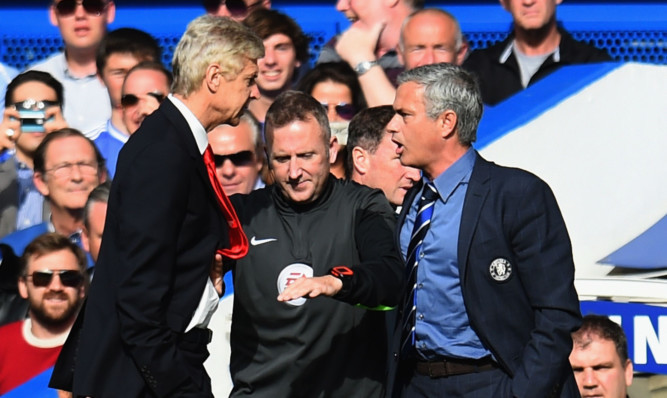
Everything already falling into place for Jose’s Chelsea.
The Premier League table, frozen briefly by the international break, makes pleasant reading for Jose Mourinho.
Chelsea are five points clear of Manchester City, who everyone believes are their biggest rivals for the title.
The rest of clubs that analysts thought would have a chance Arsenal, Liverpool, Manchester United, Spurs, Everton look capable of only scraping into the top four at best.
So while his players are scattered around the world with their countries, Mourinho can sit back at the club’s Cobham training base with phase one of his calculated plan to regain his previous supremacy in English football almost complete.
He would have liked to have been in this position this time last year but he couldn’t make the plan work with the players he inherited when he returned to the club.
He had strikers he couldn’t rely on and too many lightweight ball players in midfield.
Even so, he took his squad to within four points of champions Manchester City points thrown away with the late home defeat by Sunderland and draw with Norwich.
He did the double over both the teams that finished ahead of him City and Liverpool but couldn’t find the ruthlessness against the lesser lights that was the hallmark of Mourinho’s first spell at the club.
This season, though, things are different. The Portuguese likes to lead from the front. That’s how he won his first two Premier Leagues by knocking the fight out of the opposition early and making sure his rivals were always playing catch-up.
In his first title season, Chelsea were beaten only once. They were second until November, then hit the front and were never caught. They finished 12 points clear of Arsenal. The following season they led from the start and had it won so early they could afford to lose their last two games and still finish eight points ahead of Manchester United.
Mourinho has done the rounds of Europe’s top clubs since but his philosophy remains the same. To make sure it happened this time, Mourinho needed the close season to be right.
World Cup summers are notoriously difficult for club managers and he could see ways of gaining an advantage over his rivals. Mourinho had precise transfer targets and he tied them up early.
He wanted a proven goalscorer because last season none of his strikers reached double figures and the £32m deal with Atletico Madrid for Diego Costa was already in place when last season ended.
He needed an experienced midfield player to replace the departing Frank Lampard. Cesc Fabregas was the first and only choice and again the details were wrapped up before he travelled to Brazil.
The replacement of Ashley Cole with Atletico’s Luiz Felipe was straightforward.
Once misfiring £50m man Fernando Torres was sent on loan to Milan, Loic Remy was brought in as back-up striker. Didier Drogba had already returned on free.
It was a textbook lesson on how to use a transfer window identify the targets, get them in quickly and without fuss, then get them playing.
Contrast that approach to Manchester United’s haphazard galactico spree, Liverpool’s “seven player solution” to Luis Suarez’s departure and Arsenal’s usual reluctance to admit they’re short up front and at the back. Mourinho was also aware that Financial Fair Play restrictions would limit Manchester City’s incoming transfers and he’d have been determined to take advantage.
In addition to the precision guided recruitment policy, Chelsea also made changes to their pre-season programme. Instead of chasing the money with high-profile friendlies across the world, Chelsea stayed much closer to home.
They played in Wycombe and Wimbledon and had a few games in easily accessible European countries like Germany, Holland and Hungary.
As Louis van Gaal complained about the miles United travelled, Manuel Pellegrini and Arsene Wenger were deprived of World Cup stars for early fixtures and Brendan Rodgers struggled to integrate half a dozen new players, Chelsea just got on with it.
With seven games gone they’ll already take some stopping.
Their next three home games are against Crystal Palace, QPR and West Brom. In between are trips to Manchester United and Liverpool, whose interest in the title would be effectively ended should they lose those matches.
Given the right results, Chelsea may have shaken off all but City after just 12 games.
If that’s the case, the first phase of Mourinho’s masterplan will be complete. Phase two will be to bring home the trophy.

Enjoy the convenience of having The Sunday Post delivered as a digital ePaper straight to your smartphone, tablet or computer.
Subscribe for only £5.49 a month and enjoy all the benefits of the printed paper as a digital replica.
Subscribe